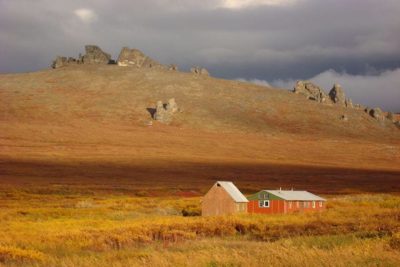One of the great activities in Alaska that can be enjoyed in both summer and winter are its hot springs! Probably one of the most popular hot springs is just outside of Fairbank Alaska – Chena Hot Springs which also has a resort/lodging. They book up rapidly so if you are planning a trip be sure to get your spot reserved soon.

Chena Hot Springs Resort
Discovered in 1905 by gold prospectors seeking to help ease the sore muscles brought on by poor diets and hard work of mining. By 1912 Chena Hot Springs had become the premier resort of Interior Alaska, visitors traveled 4 to 14 days by stagecoach from Fairbanks. Today you can easily get there by car in less than 2 hours.

Circle Hot Springs
Around 100 miles up east of Fairbanks, the springs are 8 miles off Mile 127.8 Steese Highway. If you are making the trip there should be a campground still located at Mile 5.7 of the Circle Hot Springs Road that offers 12 camping areas with toilets, tables and firepits. (Ketchum Creek BLM Campground). At the underground aquifers, all year swimming, lodging, nourishment, staple goods, pastry shop, gas and camper stopping are accessible. Circle Hot Springs was found in 1893 by miner William Greats. In 1905, Franklin Leach homesteaded around the springs. Tents were utilized as the main bathhouses. Numerous diggers wintered over at the springs when they couldn’t chip away at the rivulets.
Shelokum Hot Springs
Headed south in Alaska you can find the Skelokum Hot Springs. Found around, 90 miles north of Ketchikan in the Tongass National Forest on the Cleveland Peninsula. A 2.2-mile trail starts at Bailey Bay only south of Shelokum Creek and prompts Lake Shelokum. At the bay to the lake is a 3-sided cover. The underground aquifers are totally undisturbed and bolster a sound populace of extraordinary algal vegetation.
Manley Hot Springs

Manley Hot Springs (pop. 77) Manley Hot Springs was a clamoring place during the mining prime, near 1000 individuals lived and worked around there, at that point called Baker Hot Springs. Today, numerous occupants bolster themselves by cultivating, chasing and angling. The underground aquifers are situated in a private nursery at mile 150.8, ensure you call ahead and gifts are welcome.
Serpentine Hot Springs

Situated inside Bering Land Bridge National Preserve. The waters of Serpentine Hot Springs have for quite some time been looked for their empowering properties. Eskimo shamans accumulated here in before times. At the point when the impact of the shamans had passed, Native healers still depended on these waters to support their adherents. Likely the most visited zone of Bering Land Bridge National Preserve, Serpentine still offers a calming break from the cruel encompassing atmosphere, and the close by rock tors make an emotional scene that draws climbers to investigate. An open use lodge is situated at the springs. Winter trails from Shishmaref and other customary towns lead to Hot Springs Creek close to the tractor trail. Navigate by snow machine and dogsled in winter arrives at the springs from the finish of the Nome-Taylor (Kougarok) Road. A 1,100-foot airstrip at the underground aquifers permits wheeled plane access.
Melozi Hot Springs
Situated on Hot Springs Creek, 30 miles upper east of Ruby. There is a gathering of 20 or so springs along the stream. A 1911 U.S. Geographical Survey group announced finding a 2-room lodge and 2 little bathhouses on the springs. Today, Melozi Hot Springs is the site of a private fly-in wild hotel.
Goddard Hot Springs
Located on the outer coast of Baranof Island on Hot Springs Bay off of Sitka Sound, 16 miles south of Sitka. This may have been the earliest Alaska mineral springs known to the Europeans and before their arrival, Indians came from many miles away to benefit from the healing waters. In the mid-1800s there were 3 cottages at Goddard that were used to house invalids from Sitka. In the late 1880s, a Sitka company erected frame buildings for the use of people seeking the water’s benefits. By the 1920s a 3-story hotel was built to provide more sophisticated accommodations. The building was purchased in 1939 by the Territorial Legislature as an overflow home for the Sitka Pioneers’ Home. After 1946 the building fell into disuse and was torn down. Today, the city of Sitka owns the property and maintains 2 modern cedar bathhouses for recreational use. A few people live year-round on nearby private land.
There are open shelters over the hot tubs, which feature natural hot springs water and cold water. The springs are very popular with area residents. The area has outhouses. Boardwalks provide easy walking. Boaters can anchor in the bay and go ashore in skiffs. This is not a place to take a boat without a chart; there are lots of rocks and shoals, especially around the hot springs. There are protected routes to Sitka and a fascinating series of coves and channels just north of the hot springs. At the springs there are campsites in a grassy meadow-like area and on higher ground. Biting black flies (whitesox) are plentiful in the summer months.
We run one of the biggest Alaska Facebook groups with over 240,000 members and growing everyday! Started in 2014, The Alaska Frontier has grown into a large Media company, sharing our unique perspective of Alaska in both written and video format. We've become a large group of like minded people sharing our love of Alaska with one another.
Within our group you will find people asking questions, sharing pictures and videos of their time in our great state. Some of these questions will get a longer response from us, as a post that you will read here.
We also find unique things to do in Alaska and have begun to create our own Video content to post on Facebook, Instagram YouTube and TikTok.
